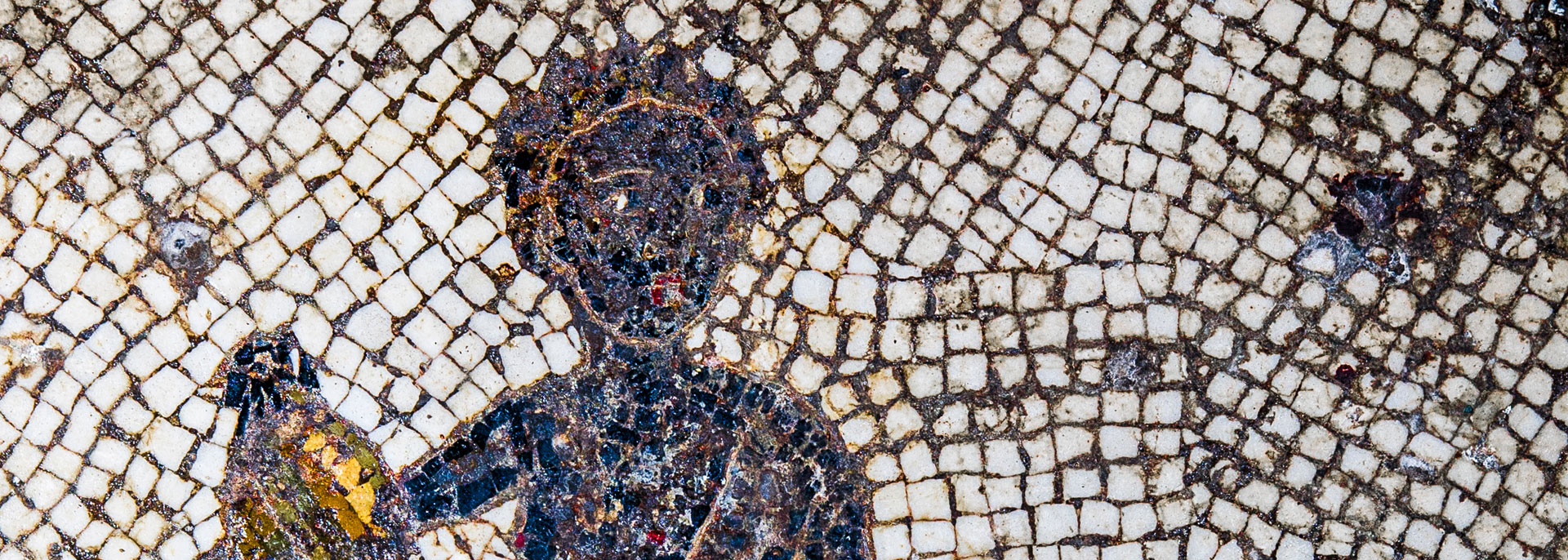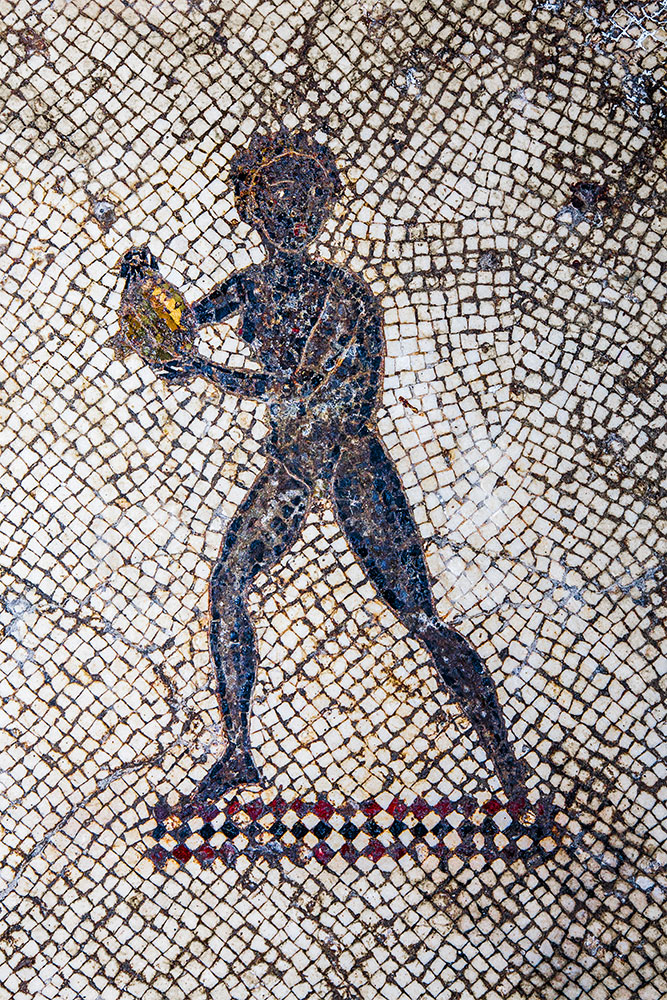"In 1934, a mosaic floor with a representation of a figure was discovered in the basement floor of the old convent of San Francesco da Paola (later the School of Art), of which Fr. E. Arias reported two years later.
At that time, an excerpt of the floor was left in view (Mt. 4.84x2.90). Due to the existing overbuilding, it was not possible to ascertain the total size of the floor, the dimensions of the room and the context of the construction. In an inspection in 1978, it was found that the floor, since then forgotten, can still be reached under a modern cover. However, scientific research is constrained by the limited surface area of the mosaic floor.
Arias's publication with the drawings and description make it clear that the floor, which is not visible at the moment, is made of coccio pesto with terraced tiles. This technique in today's terminology is referred to as opus signinum and not as opus sectile. In the centre, in a white rectangle bordered by red and black bands, shines a 53 cm high isolated figure. Before this figure, there is a large white mosaic square measuring 0.77 m2, also bordered by bands. It probably served as an entrance mosaic, so as to attract the gaze of those who crossed the threshold.
The nude figure in the centre of the floor proceeds towards the left, while turning his head he looks back. In his outstretched right hand he holds an oval object, painted green, yellow, white and black on top. The figure is outlined in black, while the nude body is depicted in grey-brown flesh-colour; only the nipples of the breasts and the lips are painted red. [...]
Analysis of the mosaic reveals a lead edging of the figure, an important detail that Arias did not mention. The strips of lead run along the outer line and mark important parts of the inside of the body, such as the crotch and the left arm, which cuts across the upper part of the body. It is striking that a lead rod is used to define facial features rather than for the contour of the head. [...]
The mosaic was intended as an entrance carpet on the floor, varying in technique and decoration. The cold white colour of the mosaic was meant to enhance the effect of the red of the earthenware. The structure of the floor, with a central rectangle, a wide marginal band and a mosaic threshold, finds numerous correspondents in Hellenistic mosaics. We can recall other Sicilian examples such as those at Morgantina and Tindari. In the choice of technique it finds exact comparisons with the meander mosaic of Taormina. [...]
The plan of the premises in Milazzo has not yet been drawn up, so one cannot with certainty pronounce on its use. It can be assumed that the room with the signinum at the edge was used as a dining room.
Arias interpreted the subject of the drawing as a female figure with a mirror. He argued that sexuality was clearly recognisable from the features of the model depicted. However, it is not certain that the nipples are female. Another interpretation also seems questionable: that the object held with both hands is a mirror. [...]
The presence of several colours is an element to exclude that it is a vase. For the identification of the original meaning of the object, a bird with multi-coloured feathers, resting on the left hand and held with both hands, is conceivable: the upper detail of the object, which in the publication is represented in the figure's right hand, can be identified as the head of a bird. This animal has beige, yellow and dark green plumage with a black head shown in profile with one eye and a short beak. [...]
The belief that the breast has a feminine characterisation, so that a hermaphrodite can be seen in the nude figure, does not seem tenable. [...] This manner of modelling the breast could indicate effeminate figures. The Milazzo mosaic lacks elements for a specific mythological meaning. It could be the young Eros. [...]
An important reference for the chronology of Sicilian mosaics is the novelty found in the use of lead strips. [...] The floor of Milazzo, together with the two rosette mosaics of Tindari and the opus vermiculatum of Solunto, are the four Sicilian examples of figured mosaics with tesserae using lead strips. [...]
As far as the stylistic characteristics of the mosaics are concerned, they consist of a simple polished frame and multicoloured bands that lack perspective motifs. In terms of style, the design is characterised by the polychrome figure reflected on a neutral white background, although the figure lacks an additional outline band. This distinguishes the Milazzo mosaic from the dark grey Hellenistic figured mosaics, while others in Morgantina and Cefalù imitate painting.
The isolated figure on a white background is essential to enhance the line of the figure itself, reinforced in places with small black contour lines. A similar style can be seen in the Hellenistic mosaic of Salemi, but whereas there the form is totally black on a white background, at Milazzo the body of the figure is modelled with different tones of colour and given a supporting line, albeit reduced to a short ornamental line. [...]
The dating given by Arias, who attributes the Sicilian mosaic to the Antonine period, is - based on technique, composition and style - to be abandoned. The floor is a Hellenistic work, roughly dating back to the 2nd century BC."
Text from 'Antike Mosaiken in Sizilien', 1983








